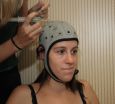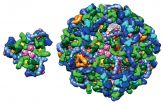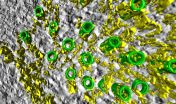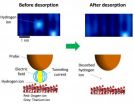(Press-News.org) Random-access memory, or RAM, is where computers like to store the data they're working on. A processor can retrieve data from RAM tens of thousands of times more rapidly than it can from the computer's disk drive.
But in the age of big data, data sets are often much too large to fit in a single computer's RAM. The data describing a single human genome would take up the RAM of somewhere between 40 and 100 typical computers.
Flash memory -- the type of memory used by most portable devices -- could provide an alternative to conventional RAM for big-data applications. It's about a tenth as expensive, and it consumes about a tenth as much power.
The problem is that it's also a tenth as fast. But at the International Symposium on Computer Architecture in June, MIT researchers presented a new system that, for several common big-data applications, should make servers using flash memory as efficient as those using conventional RAM, while preserving their power and cost savings.
The researchers also presented experimental evidence showing that, if the servers executing a distributed computation have to go to disk for data even 5 percent of the time, their performance falls to a level that's comparable with flash, anyway.
In other words, even without the researchers' new techniques for accelerating data retrieval from flash memory, 40 servers with 10 terabytes' worth of RAM couldn't handle a 10.5-terabyte computation any better than 20 servers with 20 terabytes' worth of flash memory, which would consume only a fraction as much power.
"This is not a replacement for DRAM [dynamic RAM] or anything like that," says Arvind, the Johnson Professor of Computer Science and Engineering at MIT, whose group performed the new work. "But there may be many applications that can take advantage of this new style of architecture. Which companies recognize: Everybody's experimenting with different aspects of flash. We're just trying to establish another point in the design space."
Joining Arvind on the new paper are Sang Woo Jun and Ming Liu, MIT graduate students in computer science and engineering and joint first authors; their fellow grad student Shuotao Xu; Sungjin Lee, a postdoc in Arvind's group; Myron King and Jamey Hicks, who did their PhDs with Arvind and were researchers at Quanta Computer when the new system was developed; and one of their colleagues from Quanta, John Ankcorn -- who is also an MIT alumnus.
Outsourced computation
The researchers were able to make a network of flash-based servers competitive with a network of RAM-based servers by moving a little computational power off of the servers and onto the chips that control the flash drives. By preprocessing some of the data on the flash drives before passing it back to the servers, those chips can make distributed computation much more efficient. And since the preprocessing algorithms are wired into the chips, they dispense with the computational overhead associated with running an operating system, maintaining a file system, and the like.
With hardware contributed by some of their sponsors -- Quanta, Samsung, and Xilinx -- the researchers built a prototype network of 20 servers. Each server was connected to a field-programmable gate array, or FPGA, a kind of chip that can be reprogrammed to mimic different types of electrical circuits. Each FPGA, in turn, was connected to two half-terabyte -- or 500-gigabyte -- flash chips and to the two FPGAs nearest it in the server rack.
Because the FPGAs were connected to each other, they created a very fast network that allowed any server to retrieve data from any flash drive. They also controlled the flash drives, which is no simple task: The controllers that come with modern commercial flash drives have as many as eight different processors and a gigabyte of working memory.
Finally, the FPGAs also executed the algorithms that preprocessed the data stored on the flash drives. The researchers tested three such algorithms, geared to three popular big-data applications. One is image search, or trying to find matches for a sample image in a huge database. Another is an implementation of Google's PageRank algorithm, which assesses the importance of different Web pages that meet the same search criteria. And the third is an application called Memcached, which big, database-driven websites use to store frequently accessed information.
Chameleon clusters
FPGAs are about one-tenth as fast as purpose-built chips with hardwired circuits, but they're much faster than central processing units using software to perform the same computations. Ordinarily, either they're used to prototype new designs, or they're used in niche products whose sales volumes are too small to warrant the high cost of manufacturing purpose-built chips.
But the MIT and Quanta researchers' design suggests a new use for FPGAs: A host of applications could benefit from accelerators like the three the researchers designed. And since FPGAs are reprogrammable, they could be loaded with different accelerators, depending on the application. That could lead to distributed processing systems that lose little versatility while providing major savings in energy and cost.
INFORMATION:
Additional background
ARCHIVE:
Storage system for 'big data' dramatically speeds access to information
ARCHIVE:
Simulating tomorrow's chips
ARCHIVE:
Streamlining chip design
LEXINGTON, Ky. (Jul. 10, 2015) -- Macrophages are cellular sentinels in the body, assigned to identify "attacks" from viruses, bacteria, or fungi and sound the alarm when they are present. However, these cells are a "double edged sword" in spinal cord injury, providing both neural repair-promoting properties and pathological functions that destroy neuronal tissue
"We know from previous research that macrophages are versatile, and signals at the injury site can stimulate repair or destruction--or confusingly, both," said John Gensel Ph.D., Assistant Professor of Physiology ...
This news release is available in Spanish.
Scientists at the Centre for Genomic Regulation (CRG), the research company Starlab and the group BR::AC (Barcelona Research Art & Creation) of the University of Barcelona developed a device that produces sounds from brain signals. This highly interdisciplinary team is led by Mara Dierssen, head of the Cellular & Systems Neurobiology group at CRG. Its ultimate goal is to develop an alternative communication system for people with cerebral palsy to allow them to communicate--and more specifically in this pilot phase, ...
The great white shark (Carcharodon carcharias) has a terrifying reputation. Shark attacks, though very rare, loom large in our imaginations, drawing intense media attention when they occur. Recent injuries in North Carolina are putting sharks in the limelight again. But going after sharks à la Jaws is not the best way to protect people in the water, said shark researchers.
California scientists found that the risk of white shark attack for individual ocean users in California has fallen strikingly, by over 91 percent, since 1950, in a study to be published online ...
Many areas of fundamental research are interested in graphene owing to its exceptional characteristics. It is made of one layer of carbon atoms, which makes it light and sturdy, and it is an excellent thermal and electrical conductor. Its unique features make it potentially suitable for applications in a number of areas . Scientists at EPFL's Bionanophotonic Systems Laboratory (BIOS) together with researchers from ICFO- The Institute of Photonic Sciences in Barcelona, have now harnessed graphene's unique optical and electronic properties to develop a reconfigurable highly ...
Men may feel threatened by female supervisors and act more assertively toward them than male bosses, which could disrupt the workplace with struggles over power dynamics, according to new research published by the Society for Personality and Social Psychology.
"The concept of masculinity is becoming more elusive in society as gender roles blur, with more women taking management positions and becoming the major breadwinners for their families," said lead researcher Ekaterina Netchaeva, an assistant professor of management and technology at Bocconi University in Milan, ...
Heidelberg, 10 July 2015 - Researchers at EMBL Heidelberg have produced detailed images of the intricate protein-coats that surround trafficking vesicles - the "transport pods" that move material around within biological cells. The study, published today in Science, provides a new understanding of the complex machines that make up the cells' logistics network.
Vesicles are responsible for transporting molecules between the different compartments within a cell and also for bringing material into cells from outside. There are several types of vesicle: each has a specific ...
University of Warwick researchers have discovered a cell structure which could help scientists understand why some cancers develop.
For the first time a structure called 'the mesh' has been identified which helps to hold together cells. This discovery, which has been published in the online journal eLife, changes our understanding of the cell's internal scaffolding.
This also has implications for researchers' understanding of cancer cells as the mesh is partly made of a protein which is found to change in certain cancers, such as those of the breast and bladder.
The ...
Treating obese pregnant women with a diabetes drug does not stop their babies from being born overweight, a study has found.
Doctors had hoped that the treatment would help to reduce obesity rates and lower the number of difficult births.
Heavier babies are more likely to grow into overweight adults. They also have a higher risk of illnesses later in life, such as diabetes and heart disease.
It is thought that the additional weight gain in the womb is caused by exposure to excess blood sugar.
Researchers tested whether treating overweight mothers-to-be with the ...
A research team comprising scientists from Tohoku University, RIKEN, the University of Tokyo, Chiba University and University College London have discovered a new chemical reaction pathway on titanium dioxide (TiO2), an important photocatalytic material.
The reaction mechanism, reported in ACS Nano, involves the application of an electric field that narrows the width of the reaction barrier, thereby allowing hydrogen atoms to tunnel away from the surface. This opens the way for the manipulation of the atomic-scale transport channels of hydrogen, which could be important ...
(BOSTON) - Traditional robots are made of components and rigid materials like you might see on an automotive assembly line - metal and hydraulic parts, harshly rigid, and extremely strong. But away from the assembly line, for robots to harmoniously assist humans in close-range tasks scientists are designing new classes of soft-bodied robots. Yet one of the challenges is integrating soft materials with requisite rigid components that power and control the robot's body. At the interface of these materials, stresses concentrate and structural integrity can be compromised, ...



